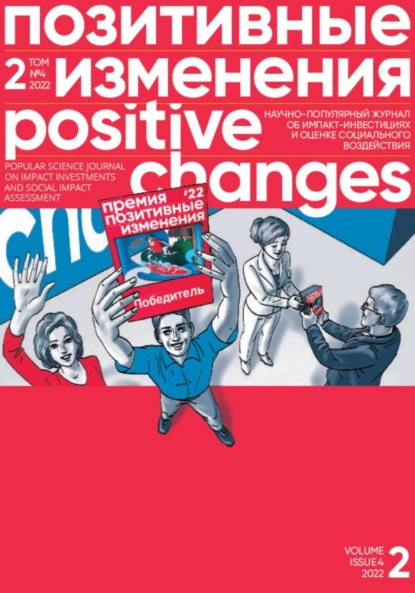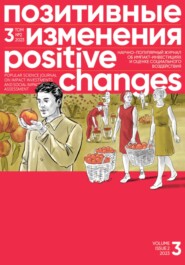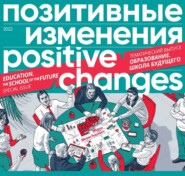По всем вопросам обращайтесь на: info@litportal.ru
(©) 2003-2024.
✖
Позитивные изменения. Том 2, №4 (2022). Positive changes. Volume 2, Issue 4 (2022)
Настройки чтения
Размер шрифта
Высота строк
Поля
Кажется очевидным, что для вовлечения максимально широкой аудитории жителей микрорайона соседскому центру важно формировать и удерживать локальную повестку развития, в отличие от движения, которое в первую очередь стало ответом на глобальный вызов с локальными лакунами решений этих проблем.
7. Приоритет стратегических решений – приоритет «пожарных» проблем.
Для целей развития и/или трансформации текущей практики логично формировать переход к «длинным» проектным и/или модельным решениям. Несмотря на кажущуюся очевидность конъюнктуры и непосредственного запроса жителей (особенно в соцсетях и чатах соседских сообществ), а также специфики работы, направленной чаще всего на адресную помощь «здесь и сейчас», это необходимо, чтобы сообщества могли видеть источники проблем и потенциал решений на базе центра и движения, проводить апробацию решений и дальнейшее масштабирование по всей ткани городов. Кроме того, они могли бы менять масштаб с локального микрорайонного уровня на общегородской или выше для обнаружения и разработки собственной теории позитивных изменений для района.
Таблица 1. Сопоставление модельной позиции соседского центра и клубов движения #мывместе
8. Акцент на раскрытие потенциала каждого (плюс профилактика социальных стигм) – акцент на существующем ядре.
Данная шкала значима как при внедрении в модель соседского центра, так и для движения, воронки роста статуса каждого жителя и допущения наличия потенциала, таланта, особенностей в каждом. Это позволит обеспечить максимально возможный спектр вовлечения и создания условий развития жизни на территории, в том числе всех форм и направлений предпринимательской инициативы в самом широком смысле, с одновременным снижением рисков развития латентных социальных проблем.
9. Приоритет социальных проектов – приоритет коммерческих проектов.
Сразу важно отметить намеренно использованную ложность данного противопоставления на шкале. У этих стереотипно полярных позиций есть одна общая и принципиально важная как для центров, так и для движения основа – предпринимательская инициатива. В какой сфере в данный момент в данной локации инициатива предпринимателя будет проявлена – значения не имеет, важнее чтобы ее реализация могла быть успешнее благодаря капиталу сообществ на базе центров и/или движения. То есть главное – чтобы горожане в принципе могли самоопределяться как акторы, субъекты социальных и экономических процессов, агенты и лидеры позитивных изменений.
10. Ценности открытости к новому, инновационность – ценности консерватизма.
Последняя шкала – своеобразный тест на готовность к устойчивому развитию – через позитивные изменения, обучение, открытость к новым решениям, способность к принятию новых проблем, перемен, технологий, взглядов на мир и его возможные траектории развития. Может показаться очевидным важность приоритета данной ценности, но при этом, когда в рамках онлайн-исследования клубов на базе движения был задан вопрос о потребности в обучении и интересах развития, большая часть ответов выражала отсутствие подобного запроса, что показывает на проблемы для трансформации, но не меняет сути выявления близости и возможности перевода текущих социальных запросов, в том числе оформленных в движения, в запрос на создание соседских центров.
Таким образом, по мнению автора публикации, озвученный подход и использование подобного рода шкал может помочь на уровне «чек-апа» инициативным группам в понимании и самоопределении в отношении развития соседского центра на своей территории. А затем, на основе либо уже существующего предложения и моделей соседских центров, либо авторского решения начать строить свою «столицу».
“Neighborhood Capital”: A Neighborhood Center as the Key to Shaping Cities and Communities
The topic of neighborhood centers has been a focus of research for more than 100 years. These days we see another rebirth of neighborhood centers. Leading development companies are making social investments in this element of the urban fabric. In this article, we reflect on the vision of neighborhood centers, their role, and their search for a development model – something you need to know before you start building your “little neighborhood capital.”
Vladimir Vainer
Director of Positive Changes Factory
THE SCIENTISTS' VIEW
The idea and concept of neighborhood centers as the key component of life development in the cities and villages in Russia has been fully revealed in recent decades in the works by Elena Shomina and Sergey Kuznetsov, Peter Ivanov, Vladimir Vainer, Svyat Murunov, as well as in the materials of Applied Urbanistics Centers and other experts and practitioners, first of all heads of neighborhood centers created by developers in new urban neighborhoods.
In the international scientific discourse, the topic of neighborhood centers has been around for more than 100 years. According to Peter Ivanov, an urbanist and sociologist at the Civil Engineering Laboratory, author and editor of the Telegram channel “Urbanism as the Meaning of Life,” “many think that neighborhoods were invented by Le Corbusier.” Those who have read Glazychev believe that neighborhoods were invented by Clarence Perry. In fact, neither is true. Microdistricts were invented by William Eugene Drummond, whom Wikipedia describes as “a Prairie School architect[69 - Peter Ivanov, “Urbanism as the Meaning of Life,” 18.03.2021 Retrieved from: https://t.me/ukszh/853 Accessed: 10.12.2022).].”
Architect William Eugene Drummond proposed the concept of a Neighborhood Unit, where a unit is understood as “part of the whole.” Drummond pointed out that the modern city (with its major projects now more than a century old) needs to recreate the social and political relations among its citizens and, consequently, the need for new special infrastructure. According to Peter Ivanov, Drummond took sociologist Charles Cooley's concept of the “primary circle of social relations” as the basis and focused attention on the neighborhood unit, the environment in which that very circle of relations – family, friendship, neighborhood – is preserved and maintained.
“Each neighborhood unit, according to Drummond, consists of low-rise apartment buildings, an elementary school, a playground and a neighborhood center,” Ivanov notes. In modern parlance, the Drummond neighborhood center is the “little capital” of the neighborhood, an amalgamation of a wide variety of functions that are still characteristic of the modern neighborhood center – a club, a place for meetings and gatherings, sports center, and so on.
In contrast to the modern developers' prevailing view of the neighborhood centers, Drummond saw them as a major tool for providing individuality and, following that, political subjectivity to the city neighborhoods. And then, each neighboring unit would create the fabric of the city itself, with business spaces and centers, parks, squares, and promenades emerging at the “junctions between the neighborhood units.”
Peter Ivanov notes that this concept became so popular that Drummond's terminology was borrowed in the 1920s by Robert Ezra Park, the founding father of the Chicago School of Sociology, who also argued that neighborhoods were the foundational core of the urban fabric. And by the 1930s, under the influence of the Chicago School sociologists, Clarence Perry offered his own understanding of neighborhood units, shifting the focus away from the political role of neighborhood centers[70 - Patricios, N. N. (2002). Urban design principles of the original neighborhood concepts. Urban morphology, 6(1), 21–36.]. It was Perry's approach, as Peter Ivanov notes, “that was creatively reworked in the USSR,” which resulted in the neighborhoods as we all know them.
From practically the only Russian-language review of Drummond's concept by Peter Ivanov, the reader can draw several important conclusions for this material:
• Neighborhood centers are a part of the neighborhood's living routine, lost during the “creative reworking,” and this might be a good time to bring this element back into the urban fabric;
• Neighborhood centers are one element of the neighborhood unit, creating a holistic structure and conditions for self-actualization of each resident, preventing stigmatization of certain groups of residents and unlocking the potential of neighborhood communities;
• Neighborhood centers create an identity for each unit of an entire city, providing (with sufficient development and scale of amalgamation) the territorial, social, and political subjectivity that we can already observe in a number of cases of the development of the Territorial Public Self-Governments or community foundations.
THE DEVELOPERS' VIEW
Positively, these findings are reflected in many ways in today's vision of the role and purpose of neighborhood centers by the leading development companies. This can be seen, in particular, from the agenda of most large-scale and regular professional events, such as the annual international conference “Factory of Spaces.” The organizer of the conference, the Blagosfera center, brings together community space owners and managers every year with a mandatory separate event dedicated to neighborhood center development. In the fall of 2022, such an event was the Neighborhood Center Leaders Session of development companies, organized in conjunction with the Positive Changes Factory.
Its key topics were those of the vision and the role of neighborhood centers, as well as the search for a neighborhood center development model that is most adequate to the contemporary situation.
According to Irina Gontarenko, Project Manager of Neighborhood Centers at Brusnika Company, each center is an element of the neighborhood's social infrastructure for self-actualization of the residents, establishing a community within itself and stimulating its development[71 - Brusnika. (2022). Vidny Neighborhood Center. Retrieved from: https://sosedi-vdn.brusnika.ru/. (Accessed: 10.12.2022).]. The roles of the community and the developer are clearly spelled out and distributed. Brusnika participates in creating the community, setting the development vector, moderating processes, assisting in managing controversial situations and providing financial support at the initial stage (the first year). The community contributes by community development activities, providing content for events, creating and implementing projects.
The community center concept presented by GloraX[72 - GloraX. (2022). GloraX Life, a vibrant community of bright people. Retrieved from: https://glorax. com/life/. (Accessed: 10.12.2022).] Head of Special Projects Olga Nerusheva emphasizes that a developed local community improves the environment and speeds up the decision-making process regarding the development of the space. Community centers also stimulate the development of micro-businesses: “cafes, schools, lectures and workshops grant opportunities to discover and realize entrepreneurial talent. The more services are provided in a neighborhood and the more diverse they are, the more willing people are to buy housing there,” she says. According to her, it's all a value-added element. “The company's experts have already recorded cases where people from nearby houses first came to the co-working room, and then moved into the apartments of the developer's projects,” Olga Nerusheva explains.
The general vector for unlocking potential is continued by the head of “We, the Neighbors” network of neighborhood centers[73 - Мысоседи. рф. (2022). We Are Neighbors. A space that we create together with you. Retrieved from: https://xn-d1abknkrb1f.xn-p1ai/. (Accessed: 10.12.2022).] of the Seven Suns Development group of companies, Daria Mashevskaya. She singles out creating exclusive conditions for human and community development, providing local accessibility (being close by), aggregating all points of positive change in the neighborhood, and purposefully influencing the development of the area as the key goals of investing in neighborhood centers.
Disclosing these goals, Daria Mashevskaya describes the objectives of introducing and uniting people sharing common interests, providing support and resources for the development and solution of problems formed within the community, including those that coincide with the values of the developer (customer). Thus, the expert notes, “we are moving from absent or sporadic communities to the creation of structured communities where residents are finding support from like-minded people, developing, working together to address urgent problems, and experiencing career growth and scaling.”
THE FOUR-STEP THEORY
The concepts described above, with their emphasis on bringing residents together and strengthening local communities, unlocking entrepreneurial potential, and aggregating all initiatives in the space of the “neighborhood capital,” in the opinion of the author of the publication, fit logically into the Four-Step Theory of Neighborhood Center Sustainability Development, presented in the 2019 methodological handbook “Setting Up a Neighborhood Center[74 - Vainer, V. (2019). Setting Up a Neighborhood Center. Moscow: Oleg Pakhmutov Publishing House.].”
Step One: Bringing locals together to share knowledge (meetings, lectures, seminars, tea parties, workshops, festivals, movie screenings, or readings). Already at the first stage – when people share with each other their discoveries, knowledge, and “life hacks,” e.g., survival tips for economically challenging conditions – we can see a process of transition from private knowledge to collective use, from private initiative to joint action, from private possession to shared use, etc., all with the “co-” prefix.
Interestingly, Elena Shomina, a key researcher of “neighborhood relations” also draws attention to this important characteristic in her work “Neighborhood Centers as an Element of Neighborhood Community Infrastructure”: “The community emerges as a result of the interaction between neighbor resident, their communication. The prefix “co-”, meaning common, shared, connects this concept with the terms “communication” and “coownership”. The latter has become especially important in modern Russian apartment buildings since the privatization of housing and the emergence of the concepts of “common property” and “common household needs[75 - Shomina, E. S. (2015). Neighborhood centers as an element of neighborhood infrastructure. Economic, Social and Humanitarian Studies, (4 (8)), 95–104.].”
Neighborhood (community) centers are commonly used by their community as a place for:
• joint celebration of events significant to the local residents;
• joint meetings of the residents on various issues;
• joint use of the premises for local clubs and various volunteer associations;
• joint collection, storage, and sharing of local history (a neighborhood museum function), etc. The manifestation of the prefix “co-” means the transition to the second level.
Step Two: pooling and sharing resources. This step is where usually collaborative crowdfunding and sharing projects are usually launched, ensuring the transition to the next level.
Step Three: launching a wide range of micro-entrepreneurial projects, both social and commercial (based on monetization of hobbies, new crafts, independent educational programs, training courses by residents for residents, etc.) on the basis of the neighborhood center. Such projects by residents and communities help improve the sustainability to monetize the center and move to the fourth level.
Step Four: The neighborhood center is a self-sustaining space, based on social cooperation, showcases of local goods and services for residents, schools and additional vocational education programs, an events calendar, and partnerships with outside companies.
The most exemplary synchronization of the four steps and the practice of a real neighborhood center was the model of the neighborhood center “We Are Neighbors,” tested and implemented in 2022 by Seven Suns Development. The model features a description of the potential development funnel for each participant in the life of the center – from a single neighbor, through uniting and launching initiatives, to the leader of the local circle, club, community, and so on. Interestingly, this funnel is also the basis for the season ticket system, which has become one of the sources of funding for the center. There is also great interest and anticipation caused by the intention of the leadership of the “We Are Neighbors” network to report in 2023 on the social impact of neighborhood centers and, in particular, the profile of the average participant in the neighborhood center activities – the neighborhood resident, with a focus on the dynamics and changes of the resident's subjectivity.
So now, a century later, we can once again be witnessing the blossoming of neighborhood centers based on social investment by development companies. And discovering new factors influencing the development of this institution given the contemporary specifics.
CRITERIA FOR SELECTING MODELS OF NEIGHBORHOOD CENTERS AND SELF-HELP CLUBS
In the early 2020s, the world entered the post-COVID time gaining a number of important elements of new social capital. In our country, one of them is a movement that grew organically on the basis of self-organization of citizens and communities, which took shape with the direct participation of a number of large NGOs and was called #WeAreTogether (#MYVMESTE) Since 2021, the movement has been managed by the Association of Volunteer Centers (AVC). The initiative is implemented differently in each region, but in 2022 AVC voiced its general aspiration – to create a network of self-help clubs for residents on the basis of this social capital[76 - The Presidential Grants Foundation. (2022). Self-Help Clubs #WeAreTogether. Transformation. Retrieved from: https://xn-80afcdbalict6afooklqi5o.xn-p1ai/public/application/item?id=21B2DCC0-D2B5–4A51-BE48–06A96F1EEFAC. (Accessed: 10.12.2022).].
Some of the experts engaged by AVCs for this transformation work to turn the movement into a club suggest that one possible vector of development could be organizing the residents' activity into neighborhood communities. Often initiated by residents, developers, or local government, they grow into neighborhood centers and their networks.














